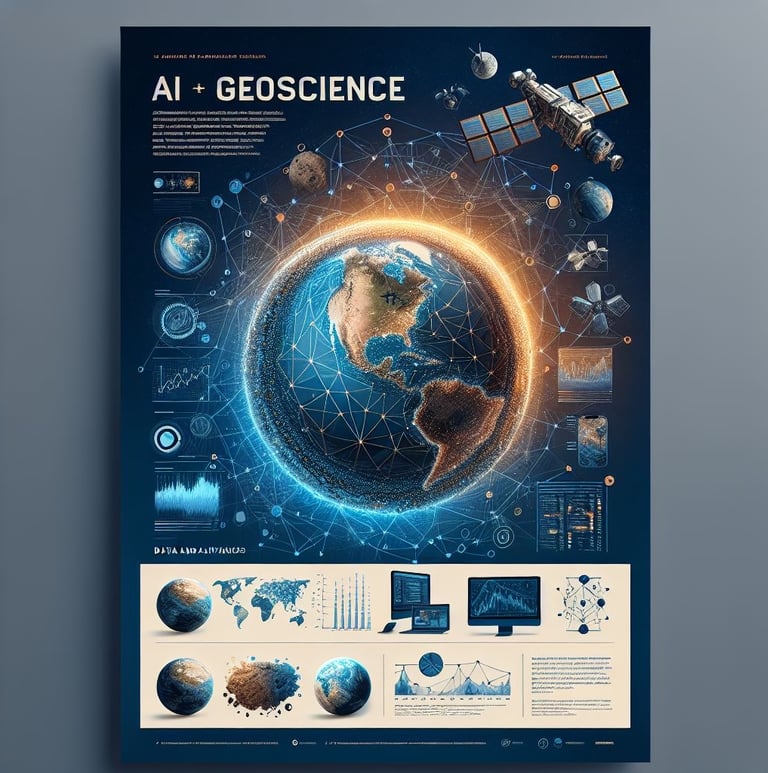Exploring the Role of AI in Geoscience: Techniques, Advancements, and Best Practices
Xuan-Ce Wang
1/19/20253 min read
Artificial intelligence (AI) is transforming geoscience research by offering novel methods to analyze complex data and generate actionable insights. Here, we delve into how AI techniques are being applied across various domains within geoscience, the potential future developments, and practical advice for researchers exploring AI tools.
1. AI Techniques in Geoscience Research
Unsupervised Machine Learning in Seismology
Theresa Sawi primarily employs unsupervised machine learning (ML) to analyze earthquake and icequake sequences. By extracting patterns from seismic waveforms and clustering them based on similarity, she gains insights into trends and changes within natural systems. Unlike supervised ML, which requires manually labeled data, unsupervised ML is particularly useful for:
Analyzing historical or unlabelled datasets.
Discovering unexpected patterns not predefined by analysts.
Although unsupervised ML can be challenging to interpret, it excels in exploratory studies and initial data analyses, enabling researchers to uncover hidden structures within data.
Deep Learning for Weather Forecasting
Mariana Clare’s work focuses on deep learning, particularly neural networks (NNs), to improve weather forecasting. At the European Centre for Medium-Range Weather Forecasts (ECMWF), Clare’s team has developed the Artificial Intelligence Forecasting System (AIFS), which uses a Graph Transformer NN. This innovative approach combines:
Attention-based mechanisms for spatial and temporal relationships.
Flexible grid structures via graph components.
AIFS achieves global forecasts with lower computational costs compared to traditional models, opening possibilities for exploring thousands of weather scenarios, particularly for extreme events.
Machine Learning and Deep Learning in Microbial Research
Haifeng Qian’s research leverages ML and deep learning (DL) to analyze microbiome data, which includes taxonomic information and gene sequences. These techniques address challenges such as high dimensionality and sparsity by:
Enhancing predictive modeling capabilities.
Identifying correlations within metagenomic data.
Discovering potential antimicrobial peptides for new antibiotics.
ML and DL provide a comprehensive understanding of microbial ecosystems and their interactions with environmental factors.
2. Future Developments in AI and Geoscience
Weather Forecasting
Mariana Clare highlights the potential for probabilistic weather forecasting models using generative AI. These models could quantify forecast uncertainty and enable higher-resolution forecasts with larger ensembles. Future AI advancements may also facilitate direct forecasting from observational data, revolutionizing weather services.
Microbial Research
Haifeng Qian anticipates that AI will enhance microbial research by integrating omics data (genomics, proteomics, metabolomics) for a holistic understanding of ecosystems. Advanced AI tools could improve real-time monitoring and predictive modeling, offering early warnings for environmental changes and pathogenic outbreaks.
Seismology
Theresa Sawi envisions physics-informed neural networks that incorporate physical laws into model training. Such advancements would reduce uncertainties, improve reliability, and enable real-time monitoring of seismic activities, significantly enhancing our understanding of earthquake hazards.
Building Trust in AI Applications
Transparency and Explainability
Enhancing model interpretability by ranking feature importance (e.g., deep forests).
Openly sharing datasets, algorithms, and methods.
Quality and Reliability
Using high-quality, well-labeled datasets and rigorous preprocessing.
Collaborating with institutions to improve data representation.
Education and Outreach
Promoting AI literacy within the geoscience community.
Encouraging reproducibility through cloud computing and accessible workflows.
3. Advice for Geoscientists Exploring AI
Understand Your Data
Theresa Sawi emphasizes the importance of thorough data preprocessing. Familiarizing yourself with your dataset’s quality, noise characteristics, and statistical features is crucial to avoid “garbage in, garbage out” scenarios.
Choose the Right Model
Haifeng Qian advises selecting models based on their explainability and suitability for the task, rather than their complexity. For example, random forests excel in biogeography predictions, while convolutional neural networks are ideal for high-dimensional spatial data.
Test and Validate Thoroughly
Employ independent datasets for cross-validation and ensure predictions are physically plausible by incorporating domain knowledge.
Leverage Community Knowledge
Engage with developers or experienced users of AI methods to learn from their expertise. Collaboration can accelerate progress and foster innovation.
Conclusion
AI techniques are reshaping geoscience research by providing powerful tools to analyze complex datasets and uncover novel insights. By embracing transparency, focusing on data quality, and fostering collaboration, geoscientists can maximize the potential of AI to address pressing challenges in their fields. With ongoing advancements, the future of AI in geoscience promises to be transformative and impactful.










